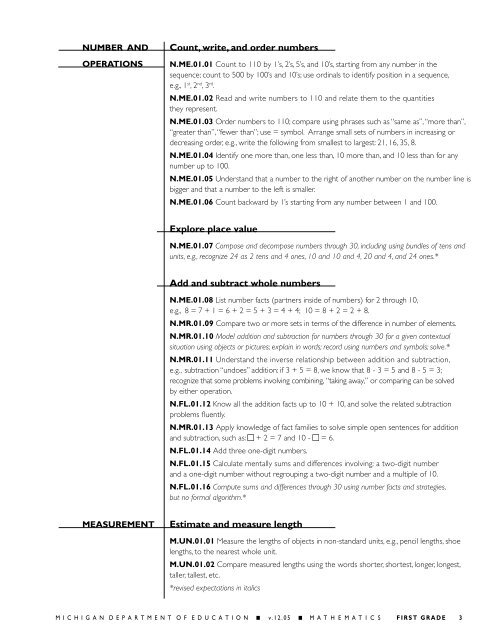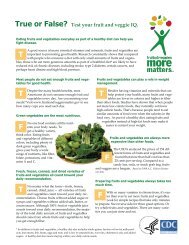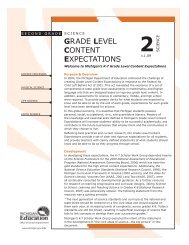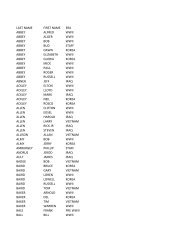Grade Level Content Expectations - State of Michigan
Grade Level Content Expectations - State of Michigan
Grade Level Content Expectations - State of Michigan
You also want an ePaper? Increase the reach of your titles
YUMPU automatically turns print PDFs into web optimized ePapers that Google loves.
NUMBER AND<br />
OPERATIONS<br />
Count, write, and order numbers<br />
N.ME.01.01 Count to 110 by 1’s, 2’s, 5’s, and 10’s, starting from any number in the<br />
sequence; count to 500 by 100’s and 10’s; use ordinals to identify position in a sequence,<br />
e.g., 1 st , 2 nd , 3 rd .<br />
N.ME.01.02 Read and write numbers to 110 and relate them to the quantities<br />
they represent.<br />
N.ME.01.03 Order numbers to 110; compare using phrases such as “same as”, “more than”,<br />
“greater than”, “fewer than”; use = symbol. Arrange small sets <strong>of</strong> numbers in increasing or<br />
decreasing order, e.g., write the following from smallest to largest: 21, 16, 35, 8.<br />
N.ME.01.04 Identify one more than, one less than, 10 more than, and 10 less than for any<br />
number up to 100.<br />
N.ME.01.05 Understand that a number to the right <strong>of</strong> another number on the number line is<br />
bigger and that a number to the left is smaller.<br />
N.ME.01.06 Count backward by 1’s starting from any number between 1 and 100.<br />
Explore place value<br />
N.ME.01.07 Compose and decompose numbers through 30, including using bundles <strong>of</strong> tens and<br />
units, e.g., recognize 24 as 2 tens and 4 ones, 10 and 10 and 4, 20 and 4, and 24 ones.*<br />
Add and subtract whole numbers<br />
N.ME.01.08 List number facts (partners inside <strong>of</strong> numbers) for 2 through 10,<br />
e.g., 8 = 7 + 1 = 6 + 2 = 5 + 3 = 4 + 4; 10 = 8 + 2 = 2 + 8.<br />
N.MR.01.09 Compare two or more sets in terms <strong>of</strong> the difference in number <strong>of</strong> elements.<br />
N.MR.01.10 Model addition and subtraction for numbers through 30 for a given contextual<br />
situation using objects or pictures; explain in words; record using numbers and symbols; solve.*<br />
N.MR.01.11 Understand the inverse relationship between addition and subtraction,<br />
e.g., subtraction “undoes” addition: if 3 + 5 = 8, we know that 8 - 3 = 5 and 8 - 5 = 3;<br />
recognize that some problems involving combining, “taking away,” or comparing can be solved<br />
by either operation.<br />
N.FL.01.12 Know all the addition facts up to 10 + 10, and solve the related subtraction<br />
problems fluently.<br />
N.MR.01.13 Apply knowledge <strong>of</strong> fact families to solve simple open sentences for addition<br />
and subtraction, such as: ■ + 2 = 7 and 10 - ■ = 6.<br />
N.FL.01.14 Add three one-digit numbers.<br />
N.FL.01.15 Calculate mentally sums and differences involving: a two-digit number<br />
and a one-digit number without regrouping; a two-digit number and a multiple <strong>of</strong> 10.<br />
N.FL.01.16 Compute sums and differences through 30 using number facts and strategies,<br />
but no formal algorithm.*<br />
MEASUREMENT<br />
Estimate and measure length<br />
M.UN.01.01 Measure the lengths <strong>of</strong> objects in non-standard units, e.g., pencil lengths, shoe<br />
lengths, to the nearest whole unit.<br />
M.UN.01.02 Compare measured lengths using the words shorter, shortest, longer, longest,<br />
taller, tallest, etc.<br />
*revised expectations in italics<br />
M I C H I G A N D E P A R T M E N T O F E D U C A T I O N ■ v. 1 2 . 0 5 ■ M A T H E M A T I C S F I R S T G R A D E 3






